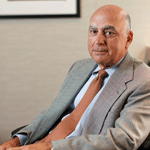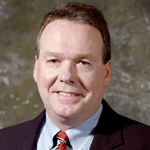
As senior vice president of information systems and CIO of Advocate Health Care, Bruce Smith is the clear-eyed captain at the helm of a ship that constantly faces changes and challenges. Under his watch are the technologies used by more than 250 care sites in the greater Chicago area. And with patient lives at stake, Smith’s job goes beyond pioneering new IT systems; he must connect the dots in the data so that Advocate’s care team can quickly capture a patient’s information.
What do you consider your most important role as CIO?
Bruce Smith: Establishing leadership and guiding the process for moving ahead. I make sure our technology supports clinical efforts and supports the organization. It’s a steering position. It’s my job to support the organization and where it’s going.
So much data is now available. At what point do you move from reviewing data to making decisions?
Smith: The physicians we work with are saying, “Tell us a story about the condition of a patient.” They want to know what’s going on with an individual. That’s a large part of the challenge—not amassing data but turning it into a story that people can work with.
What developing technology are you most excited about seeing come down the line in IT for health care?
Smith: Mobility application. We’re seeing physicians interested in adopting smartphones and tablets. We’re excited about the mobility factor. Physicians never relate well to fixed devices sitting at a computer. That stuff doesn’t work the way they work.
How do new regulatory implications affect your role?
Smith: We take all that in stride. With HIPAA a few years ago, we made a strong effort to understand the requirements and implement those. We work with other parts of the organization and do a lot of education with the staff explaining the rules. We put in a lot of controls and protections to ensure privacy of the individual and data.
How does the new way patient records are processed affect your role in IT?
Smith: There are now additional layers of security. We have training when it’s appropriate, and we’ve tightened access points. Because it’s been a gradual process, we’ll look back in the future and see that the changes affected more than what we’re feeling today. We’re at a much more secure point than 10 years ago.
IT budgets are playing a larger and larger part in the expenses of the modern company. How do you know when a new technology is worth the investment?
Smith: It’s not always easy to measure the value of necessities. The value of IT comes down to determining how much the business values what you’re doing. If they value you more, then you get more resources. Traditionally in health care, IT budgets are small. In recent years, they have grown more and more. One thing we do know is that we rarely have system problems. When we do, it disrupts everything—if you try to take the systems away the place would not be able to run. It’s critical for the day-to-day function.
Is it a challenge to figure out what is most user-friendly for doctors and users?
Smith: The difficult part is that health care is going through an upheaval from paper to electronic. If you go back 5 or 10 years ago, health care was almost exclusively a paper-based industry. We’re now in the middle of a challenging transition that physicians don’t necessarily want to make.
How have you built an IT team capable of handling these transitions?
Smith: We have had a stable workforce. Much of our leadership has grown with the organization as Advocate has grown in size and complexity. It’s almost been a learning lab for us: as we got bigger and faced more complexity, we grew as a team together. I learned people are much more effective if they’re invested in the decision and the direction. We agree upon outcomes and goals that they need to achieve.
How do you balance giving your VPs the power to make decisions while maintaining quality control?
Smith: We establish the expectations for the outcome. We make sure we’re on base in terms of expectations, deliverables, budget, and timing. We have a lot of conversations. Everything is planned out.
What is your leadership philosophy?
Smith: The key is hiring good people, training them well, and keeping them on board. We have a long-term information-technology team—some people have been here for 20-plus years. We have a lot of consistency in leadership. Also, I delegate a lot of power and decision making to my vice presidents. I let them make decisions and then hold them accountable. They have the freedom to pick vendors and sign contracts as long as we’re in agreement as to the end goal.
What’s the best piece of career advice you would give to someone just starting out in your field?
Smith: Get results. Show progress. Show improvement. Show value. Organizations value people who are able to get things done. There are two types of people: reasons people and results people. Do you always have a reason or do you always get results? Also, it’s necessary to have a passion for your field. IT is not easy work and there are a lot of barriers you must be willing to deal with. If you care about it and have a passion for it you tend to do much better.














